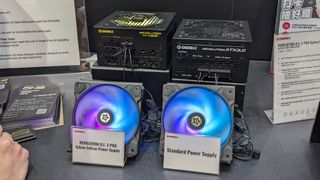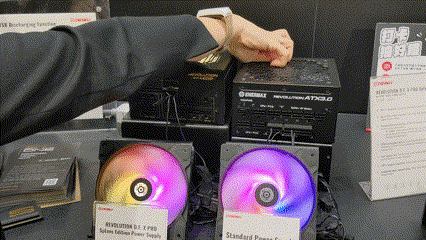Off means off: Splave Edition PSU has no residual power, discharges as soon as you flick the switch
Most power supplies keep juicing your motherboard while they are off.

Ever pull a charger out from the wall plug and notice its power light stay on for several seconds? The same kind of residual power remains in even the best power supplies' capacitors juicing your PC's motherboard for as long as a minute after you hit the off switch.
For serious overclockers, residual power is a real problem. If you're overclocking, you can expect to push the envelope with your BIOS settings and cause your system to crash; it's all part of the process. You turn the computer off, and, if you turn it back on before the power is gone, you may have the same bad settings in memory or you could damage sensitive components. If you have to wait an extra 30 seconds or a minute for the PSU to discharge after every crash, that's an annoying waste of time and a killer during competitions.
Enter the Enermax Revolution D.F. X Pro Splave Edition power supply. Designed with input from world-famous overclocker (and occasional Tom's Hardware contributor) Allen 'Splave' Golibersuch, this ATX 3.1 PSU immediately discharges the 5VSB rail, cutting off the juice to your motherboard and clearing its BIOS right away.
"Power is drained almost instantly whereas a normal PSU can take minutes," Splave told us in an email. "It's great for clearing CMOS quickly or fully cutting the PSU to fresh boot when overclocking."
We got a demonstration of the Splave Edition PSU's 5VSB discharge at Enermax's Computex booth and it works as advertised. While we watched, an Enermax representative showed us two, nearly-identical power supplies: one a Splave Edition and one a regular Enermax PSU. Both were connected to RGB fans which were spinning. When the rep turned off the power on both PSUs, the fan on the Splave PSU went dark right away while the other remained lit up and spinning for several seconds.

Splave noted that having this kind of immediate power discharge is helpful not only for overclocking but making quick parts changes during a PC build (see how to build a PC).
"If you are swapping components during testing, you have probably seen before your motherboard light up or a GPU red light coming on even with the power supply in the off position. I've had this before when changing motherboards. I plugged the PSU in and then installed the CPU and I heard some clicks on and off a couple times, even though the PSU was switched off," he told us. "It's just safer all around to have off be off and not some form of middle ground."
Stay On the Cutting Edge: Get the Tom's Hardware Newsletter
Get Tom's Hardware's best news and in-depth reviews, straight to your inbox.
The Splave Edition PSU is due out in September in 1,000 watt and 1,200 watt capacities for $169 and $189 respectively. It also features a 235 percent power excursion over 100 μs for the 12V connector, an improvement over the ATX 3.1's 200-percent standard. The individually mesh-sleeved cables are easy to bend and the fan has a feature where it rotates backwards for 20 seconds after you turn it off in order to blow out dust.
For those who care about aesthetics and not just overclocking, the PSU has 23 different RGB lighting effects you can invoke by hitting a button on the back of the unit. You can also control the lighting through software.
-
bill001g I guess if that is important to you. Most motherboards have led and other fancy stuff that pull power when the machine is shutdown but the power switch is still on. Those will quickly drain the caps when you turn the switch off or unplug it.Reply
For your average uses the small bit of extra power stored in the caps is a good thing. Acts as a tiny UPS to get past those power hits that a fraction of a second. -
bit_user Reply
This.bill001g said:I guess if that is important to you. Most motherboards have led and other fancy stuff that pull power when the machine is shutdown but the power switch is still on. Those will quickly drain the caps when you turn the switch off or unplug it.
And if that LED doesn't drain it fast enough for you, then I'd suggest these overclockers should probably attach a resistor or similar (light bulb?).
I think I've also seen the Ethernet activity LED being active in this period (network needs to stay on, during "soft" poweroff state, in order to support "wake on LAN").
I think this is what they mean by "hold up time", which you often see measured in PSU reviews.bill001g said:For your average uses the small bit of extra power stored in the caps is a good thing. Acts as a tiny UPS to get past those power hits that a fraction of a second.
BTW, I recently did some minor work on a motherboard (grinding off some of the leads poking through the bottom side... it's a longer story) and neglected to remove the CMOS battery, during the process. When I powered it on, it went through a couple reboots and the BIOS reset itself. My best guess is that I had shorted out something that was being powered by that battery, leading to some sort of corruption in the settings and thus the need for it to wipe everything out and start from factory defaults. -
TJ Hooker If the main goal is to quickly and easily clear CMOS, just get a motherboard with an external clear CMOS button? Pretty sure most high end mobos (the kinds series overclockers would be using anyway) already include that.Reply
Most Popular


